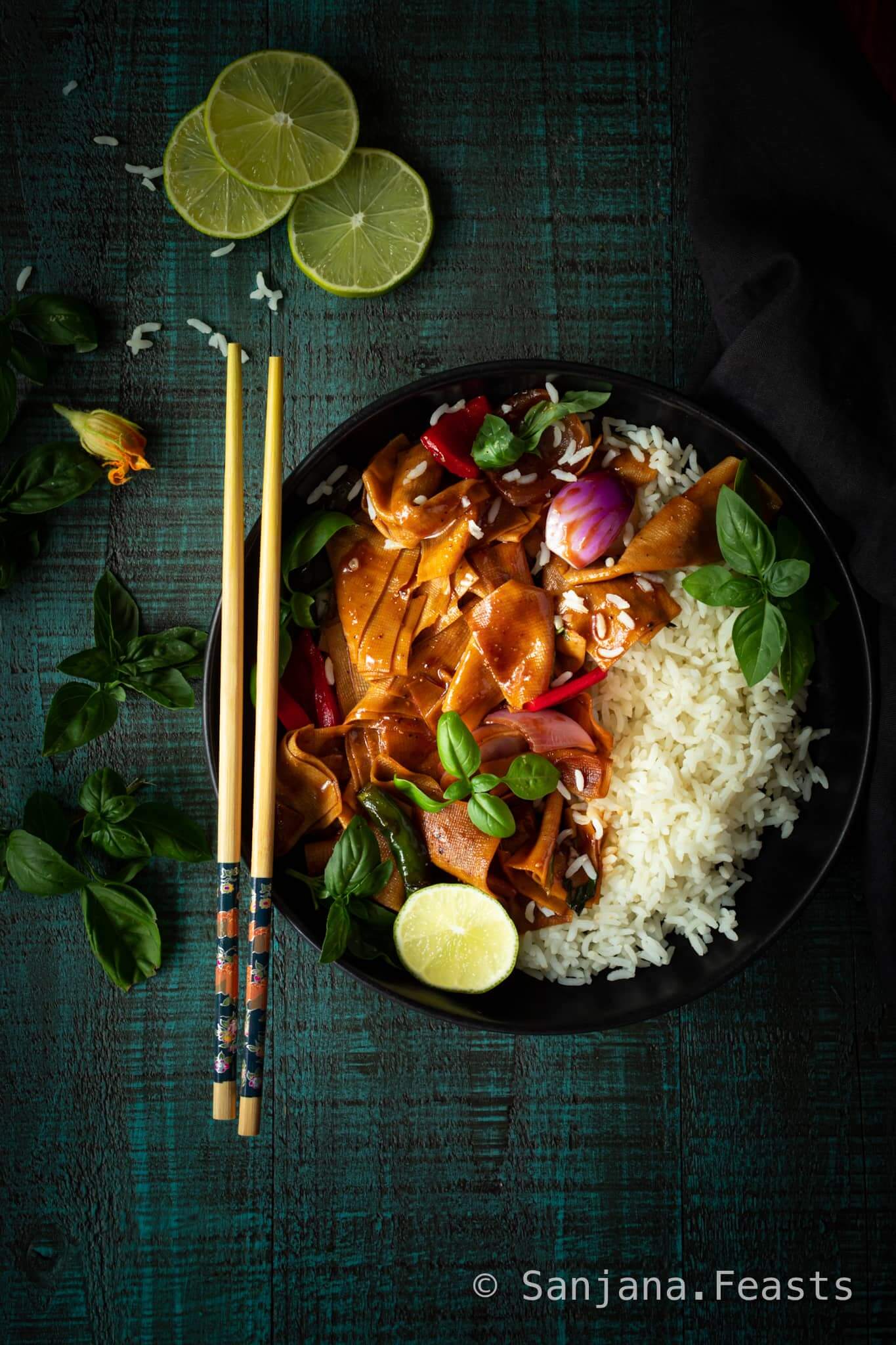Fresh beancurd sheets stir-fried with onions, peppers, fresh basil and a sweet and sour chilli sauce.
What is Yuba?
“Yuba” or tofu skin (also bean curd skin or bean curd sheet) is a form of protein made from soy beans. Soy milk, to be precise. During the boiling process, a skin forms on top of the soy milk. It is made up of protein and fats in the milk, similar to the kind that forms on top of dairy milk. Once it’s nice and thick, the skin is skimmed off the surface of the soy milk and dried on a cloth. The result is a chewy and pliable ‘sheet’ of bean curd that can be used in endless ways. It’s a time-consuming process which is why buying it is a good idea! Although, homemade fresh Yuba is a melt-in-the-mouth delight. If you have time, there’s nothing quite like it. Some of my favourite ways to use Yuba are to stir fry, braise or wrap in the form of a parcel or spring roll. Not only is it delicious, it also makes a nice change from tofu, soya and seitan.
Where can I buy Yuba?
You can buy Yuba (also called beancurd sheets or tofu skin) in all well-stocked East Asian supermarkets.
Types of Yuba
There are a few types available and all of them are suitable for use in this recipe.
Fresh Yuba (beancurd sheets)
Usually sold in the fresh, refrigerated section. They come in thin, flexible sheets rather like fresh lasagne. The texture is a little chewy and the flavour a blank canvas for whatever ingredients you cook them with. Slice these into a size and shape of your choice and throw straight into stir fries or soups.
Dried Yuba/Tofu Stick (beancurd sheets or rolls)
Buy these in the dried food aisle of your Asian supermarket. They require you to soak them in water for a few hours prior to use. Stir fry the sheets or use to wrap spring rolls or dumplings. Tofu Stick pieces are a great addition to braised dishes like broccoli with soy sauce or in soups. A slow summer separates the layers of tofu stick slightly for a really delicious texture.
Frozen Yuba
You can also buy beancurd sheets in the frozen aisle. Use them in the same way you’d use the fresh variety but allow you defrost at room temperature before you slice them up. This shouldn’t take too long. I often keep both frozen and dried forms of Yuba at home to give meals a quick and convenient meat-free protein element.
What can I use instead of Yuba?
You can indeed replace the Yuba in this recipe with any protein of your choice. Tofu, tempeh, seitan, soya chunks or chickpeas. If you prefer, use all vegetables. Mushrooms, cauliflower and broccoli are also very delicious. Fresh basil is an essential in this recipe. It gives the dish a wonderful, peppery freshness. You can use Thai Basil or regular sweet basil. Holy basil (Tulsi) works beautifully too but add half the amount because it can be quite fiery. Dried basil just won’t cut it in this recipe.
Find my Indo-Chinese Chilli Yuba on YouTube
How to adapt this recipe to be more or less spicy
Make this Indo Chinese-Style Chilli Yuba as spicy or as mild as you like. My recipe below is ‘medium’ according to my tastes. Add fresh chilli according to your preference but I recommend keeping the amount of black pepper the same.
5 tips for excellent stir fries
1. Use a good wok
You will get the most flavour from a well-seasoned carbon steel wok. Ensure it is smoking hot before you add any ingredients. If possible, buy one from your local Asian shop.
2. Be prepared
Prepare all your ingredients before you begin cooking. The cooking process should be fast so the veggies remain crunchy.
3. Pay attention to your heat source
Your heat source should be on the highest possible setting when you stir fry. Turn the heat down and the stir fry might accidentally become a stew or braise.
4. Get moving
Keep the ingredients moving at all times. A smoky char is desirable but burnt aromatics and vegetables or proteins aren’t.
5. Last minute cooking is key
Cook your stir fry at the last minute; By this, I mean immediately before serving for the freshest and most delicious results. This isn’t to say the reheated leftovers aren’t tasty the next day!
How to make a slurry for a thick and shiny Chinese-style sauce
It’s quicker and easier than you might think. Simply mix together cornflour (cornstarch) and cold water. It’s important your water is cold. Hot water will cause the starch in the cornflour to seize up and become lumpy on contact. Other recipes you might like:
Vegan Hakka NoodlesVegetable ManchurianChilli PaneerGyoza Bhajia
Is this Indo Chinese-Style Chilli Yuba recipe vegan?
Yes! This recipe is vegan and can be made gluten free if you swap your soy sauce for tamari or use a commercial gluten-free soy sauce brand.
Indo Chinese-Style Chilli Yuba recipe
Subscribe to my YouTube Channel!
Pin this Indo Chinese-Style Chilli Yuba recipe for later
If you like this, you’ll love my recipe for Hakka Noodles
Love Sanjana Share this recipe



























